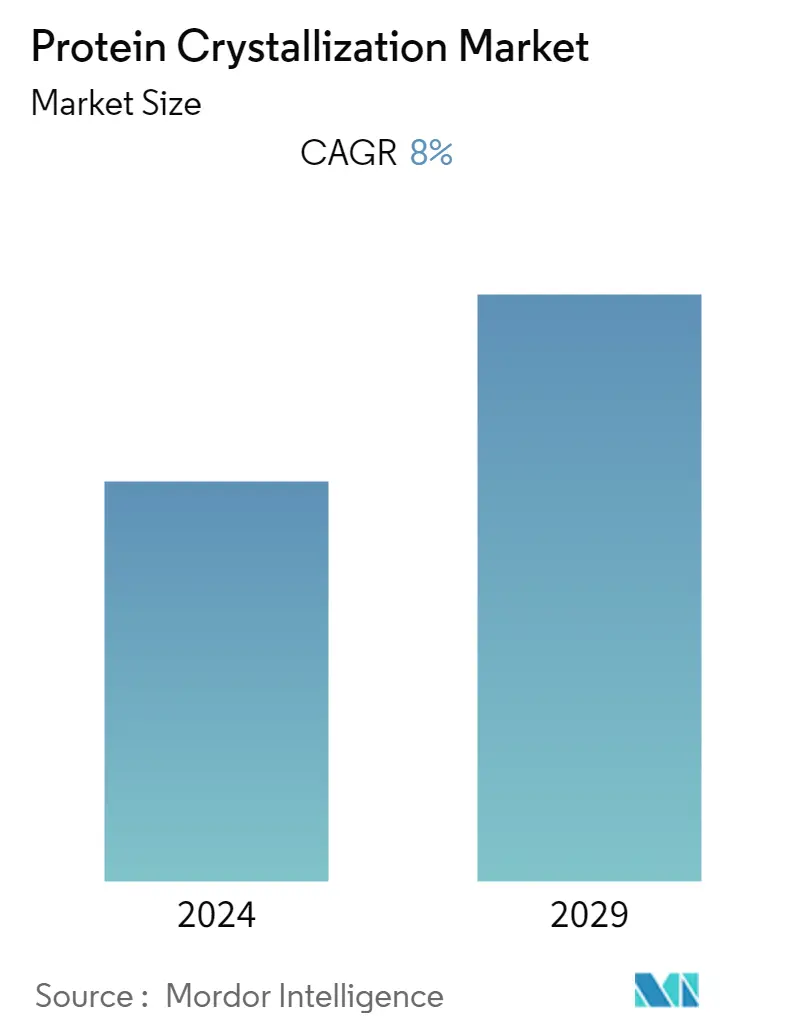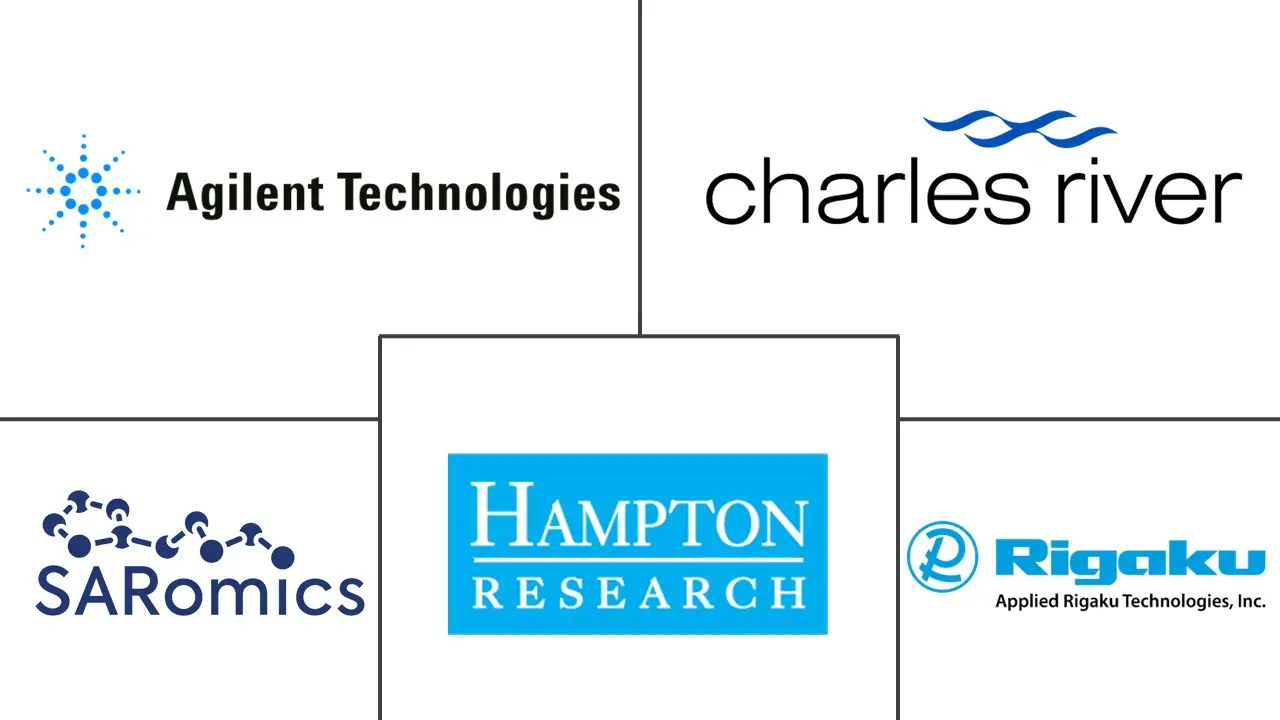Market Size of Protein Crystallization Industry

| Study Period | 2019 - 2029 |
| Base Year For Estimation | 2023 |
| Forecast Data Period | 2024 - 2029 |
| CAGR | 8.00 % |
| Fastest Growing Market | North America |
| Largest Market | Asia-Pacific |
Major Players
*Disclaimer: Major Players sorted in no particular order |
Protein Crystallization Market Analysis
The protein crystallization market is projected to register a CAGR of 8% during the forecast period.
COVID-19 significantly impacted the growth of the protein crystallization market as the rise in cases of infectious diseases among the population increased the demand for vaccines and protein-based therapies to overcome infection. The extensive use of protein crystallization to develop COVID-19 drugs has contributed to the market's growth. For instance, in January 2021, Elasmogen identified protein-based drugs to potentially stop COVID-19 infections through a partnership with the University of Minnesota. Thus, the agreement was signed between market players and the research institute with a focus on research for COVID-19 protein therapeutics, which created the need for protein crystallization. Therefore, during the initial pandemic, there was a slight decline in the studied market during the early pandemic due to supply chain restrictions and manufacturing delays. However, the market has gained traction due to increased demand for protein crystallization during the late pandemic. Furthermore, the market has attained a significant pace post-pandemic due to the increased development of antiviral drug development based on the data analysis of expression of genes, chemical structure, molecular pathway, and protein interaction mapping.
The factors driving the growth of the market include increasing investment in the research and development of biopharmaceuticals and increasing adoption of protein therapeutics.
The increasing demand for protein therapeutics is a key factor driving the market's growth. This is because protein therapeutics have become integral to the healthcare industry over recent years. Due to their low immunogenicity and specificity, protein therapeutics are extensively used to treat various major diseases, such as cancer. The increasing demand for protein-based drugs and therapeutics has led the manufacturers to implement growth strategies to gain the major market share, thereby increasing the market's growth. For instance, in January 2022, Amgen partnered with Generate Biomedicines to discover and create protein therapeutics for five targets across several therapeutic areas and multiple modalities. Such research and development activities create the need for protein crystallization products and services, thus driving the market's growth.
Furthermore, the increasing demand for protein therapeutics is due to the increasing prevalence of chronic disease and rising awareness regarding protein therapeutics' efficiency. According to the American Cancer Society 2023, it is estimated that 1,958,310 new cancer cases are projected to occur in the United States in 2023. Such a huge incidence of cancer in developed regions creates a need to develop novel and efficient drugs, and as protein crystallization is widely used in drug discovery and development, it is expected to propel the growth of the market.
Advancements in protein crystallography and the implementation of standard protocols create a lucrative opportunity for market growth. Increasing application fields and areas of protein crystallization for tailoring effective drug candidates contribute to the market's growth over the forecast period. For instance, in October 2022, the Tokyo Institute of Technology developed a new cell-free protein crystallization (CFPC) method that provides major developments in the field of structural biology, including direct protein crystallization. The technique enables the analysis of unstable proteins that cannot be studied using other conventional methods.
Thus, owing to the abovementioned factors such as rising advancements in protein crystallization, rising incidence of chronic diseases, and rising initiatives from the key market players is expected to show positive growth of the market studied over the forecast period. However, the lack of skilled professionals and the high cost of instruments may impede the growth of the market.
Protein Crystallization Industry Segmentation
As per the scope of this report, protein crystallization is the act and method of creating structured, ordered lattices for complex macromolecules. The most common reason for creating protein crystals is to support structural biology investigations via different techniques such as X-ray crystallography, NMR spectrometry, and others. It is also a method to produce pure, stable, solid dosage forms and several injected and infused therapeutics that are associated with protein crystals. The protein crystallization market is segmented by technology (X-ray crystallography, NMR spectroscopy, and others), product (instruments, reagents or consumables, and services and software), end-user (pharmaceutical and biotechnology industries and others), and geography (North America, Europe, Asia-Pacific, Middle East and Africa, and South America). The market report also covers the estimated market sizes and trends of 17 countries across major regions globally. The report offers values in USD for the above segments.
| By Technology | |
| X-ray Crystallography | |
| NMR Spectroscopy | |
| Others |
| By Product | |
| Instruments | |
| Reagents or Consumables | |
| Services and software |
| By End User | |
| Pharmaceutical and Biotechnology Industries | |
| Others |
| Geography | ||||||||
| ||||||||
| ||||||||
| ||||||||
| ||||||||
|
Protein Crystallization Market Size Summary
The protein crystallization market is experiencing robust growth, driven by the increasing demand for protein therapeutics and significant advancements in biopharmaceutical research. The market's expansion is largely attributed to the heightened need for vaccine development and protein-based therapies, particularly in response to the COVID-19 pandemic. This surge in demand has led to increased investments in research and development, as well as strategic partnerships among key industry players and research institutions. The pharmaceutical and biotechnology sectors are poised to be the most lucrative segments, with protein crystallization playing a crucial role in drug discovery and development processes. Innovations such as the development of new cell-free protein crystallization methods and collaborations to create comprehensive protein structure databases are further propelling market growth.
North America is expected to maintain a significant share of the global protein crystallization market, supported by technological advancements and a strong focus on research and development in the biopharma sector. The region's growth is bolstered by collaborative efforts between industry players and research institutions, aimed at developing next-generation protein-based drugs. Despite the competitive landscape, characterized by initiatives like strategic partnerships and innovative product launches, challenges such as the high cost of instruments and a shortage of skilled professionals may impede market growth. Nonetheless, the ongoing expansion of facilities and the increasing application of protein crystallization techniques are anticipated to drive the market forward over the forecast period.
Protein Crystallization Market Size - Table of Contents
-
1. MARKET DYNAMICS
-
1.1 Market Overview
-
1.2 Market Drivers
-
1.2.1 Increasing Investment in the Research and Development of Biopharmaceuticals
-
1.2.2 Rising Adoption of the Protein Therapeutics
-
-
1.3 Market Restraints
-
1.3.1 Lack of trained Personnel
-
1.3.2 High cost of the Instruments
-
-
1.4 Porter's Five Forces Analysis
-
1.4.1 Bargaining Power of Suppliers
-
1.4.2 Bargaining Power of Buyers/Consumers
-
1.4.3 Threat of New Entrants
-
1.4.4 Threat of Substitute Products
-
1.4.5 Intensity of Competitive Rivalry
-
-
-
2. MARKET SEGMENTATION (Market Size by Value - USD)
-
2.1 By Technology
-
2.1.1 X-ray Crystallography
-
2.1.2 NMR Spectroscopy
-
2.1.3 Others
-
-
2.2 By Product
-
2.2.1 Instruments
-
2.2.2 Reagents or Consumables
-
2.2.3 Services and software
-
-
2.3 By End User
-
2.3.1 Pharmaceutical and Biotechnology Industries
-
2.3.2 Others
-
-
2.4 Geography
-
2.4.1 North America
-
2.4.1.1 United States
-
2.4.1.2 Canada
-
2.4.1.3 Mexico
-
-
2.4.2 Europe
-
2.4.2.1 Germany
-
2.4.2.2 United Kingdom
-
2.4.2.3 France
-
2.4.2.4 Italy
-
2.4.2.5 Spain
-
2.4.2.6 Rest of Europe
-
-
2.4.3 Asia-Pacific
-
2.4.3.1 China
-
2.4.3.2 Japan
-
2.4.3.3 India
-
2.4.3.4 Australia
-
2.4.3.5 South Korea
-
2.4.3.6 Rest of Asia-Pacific
-
-
2.4.4 Middle East and Africa
-
2.4.4.1 GCC
-
2.4.4.2 South Africa
-
2.4.4.3 Rest of Middle East and Africa
-
-
2.4.5 South America
-
2.4.5.1 Brazil
-
2.4.5.2 Argentina
-
2.4.5.3 Rest of South America
-
-
-
Protein Crystallization Market Size FAQs
What is the current Global Protein Crystallization Market size?
The Global Protein Crystallization Market is projected to register a CAGR of 8% during the forecast period (2024-2029)
Who are the key players in Global Protein Crystallization Market?
Rigaku Corporation, Hampton Research Corp, SARomics Biostructures AB, Agilent Technologies Inc. and Charles River Laboratories Inc. are the major companies operating in the Global Protein Crystallization Market.

